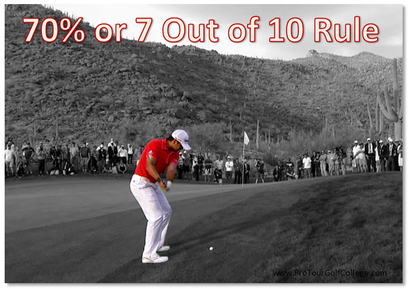"We have known professional golfers who have attempted complex swing changes with their golf swing instructor whilst trying to compete in tournaments. This makes not one bit of sense." I was thinking the other day how much easier it would be for serious amateurs and even professional golfers to improve their golf swing if they understood some very simple planning concepts that would make it much easier to determine when to perform work on their golf swing and when not to. Developing and improving your golf swing is more difficult the closer to par you get simply because making changes to golf swings at this level usually means an increase in the amount of mistakes made on the golf course and a score average that starts to climb. Not to mention the hit your confidence level takes. So how do you make changes to your golf swing where you go from not yet competent to competent without dramatically affecting your performances on the golf course in tournaments? If you are a serious golfer then playing in tournaments is a priority for you. Therefore the key to managing the swing change process is to identify the ideal time in your schedule to make the change so that you can be ready to perform when your tournaments come around.  The Swing Change Taper For example, imagine that your tournament season started in March, when do you think would be the best time to work on swing changes in preparation for the start of your season? If the tournaments begin in the middle of March, you should have ceased working on technical changes at least 6 weeks out from your first tournament. That’s right; you need this much time to make the transition from technical skill development into targeting skill (shot-making) development. So how long do you spend in the technical phase to ensure that your change is habituated enough to perform with it? Well it depends, but ideally your swing development process would start at the end of your previous season, so let’s say that your season ended in October, then you would work on your swing change through November, December and January and you’d finish the technical phase by the start of February. You can see that you would be spending fully 12 weeks working on making the changes and giving you enough lead time to develop your shot-making powers prior to competing in your first tournament. Now there is a caveat or cautionary note here. The change to your golf stroke should rate as very low on the complexity scale. That is, the more complex the change (i.e. more elements involved in the change), the longer it will take.  The 70 Percent Rule We have known professional golfers who have attempted complex swing changes with their golf swing instructor whilst trying to compete in tournaments. This makes not one bit of sense. To compete in tournaments you need all your skills to be at a very high level of competence, trust and confidence. In our program we suggest to our students that they reach a 70 percent threshold in skill competency before they take their new swing into battle. When you make a change to your golf stroke (any type of stroke) you will begin at a low level of competence where mistakes are high and confidence and trust is low. This is a normal part of the change process and every golfer has to go through this. But there’s a way to ensure that the change you make is manageable so that you can achieve a high level of competence, trust and confidence within your 18 week development window. Reduce Complexity to Increase Competency When you are planning to make the change to your golf stroke you should sit down with your instructor to determine what needs to change and why. Why you make the change is very important, and the rule here is simple; only make the change if you know that it will lead to a lower score average. Do not make the change to make the stroke look better, it must function better, and ultimately lead to a lower score average. The professional golf tours are full of golfers with great looking golf swings who can’t make nearly enough cuts to make a living on tour. This is a sad reality of elite golf, and from our perspective it doesn’t have to be this way. The point we are making here is make the change to improve your score average, or don’t make the change at all, because once you start on the path to change you can’t go back. Now you may not agree with this advice, but ask yourself why you want to improve some aspect of your golf stroke. I’m sure when all is said and done you want to write lower scores on your score card. We have seen many golfers who had good intentions of changing their golf swing only to discover that they got worse, and worse yet, they never got back to their original performance level.  Keep It Simple So how you manage the change process begins with an informed decision about how much of your stroke needs to change. Think about it like this, if you can change just one aspect of your stroke—say moving a right hand grip position from too weak to neutral, then that would be a change in the low complexity sphere. However, also add a change to how you cock the club on the backswing as well, and the complexity level of the change rises skyrockets upwards. Golfers have an inclination to try to do more to their golf swing to somehow accelerate the change process, but they do this without realizing that the change they thought would take a short time to habituate actually takes a lot longer than they anticipated. And it is a lot more painful mentally and emotionally as well. The old saying of “keep it simple” is good advice here. Keep you change down to one simple and easy to learn chunk of information. Think about it like this, one part of the stroke is one chunk of information, it should be relatively easy to learn and do. If it is relatively easy to learn and do you will learn it faster. Now give it the lead time it needs, in our example we suggested 12 weeks to implement a minor technical change, and fully 6 weeks after that to get it ready for a tournament. Making changes to a golf swing technique need not be difficult or even painful if you plan for the change process well in advance. In our next article we’ll show you a really good way to design your golf swing change process so that you can be ready and able to perform at your best when your first tournament of the season comes around. See you then. Lawrie Montague and David Milne – Pro Tour Golf College The Professional Golf Tour Training College Perth / Jakarta Comments are closed.
|
Archives
June 2019
|
Proudly Supported By
Copyright © 2011 - 2018 Pro Tour Golf College
Website Managed By Golf Performance Media
All Rights Reserved
Website Managed By Golf Performance Media
All Rights Reserved




 RSS Feed
RSS Feed



